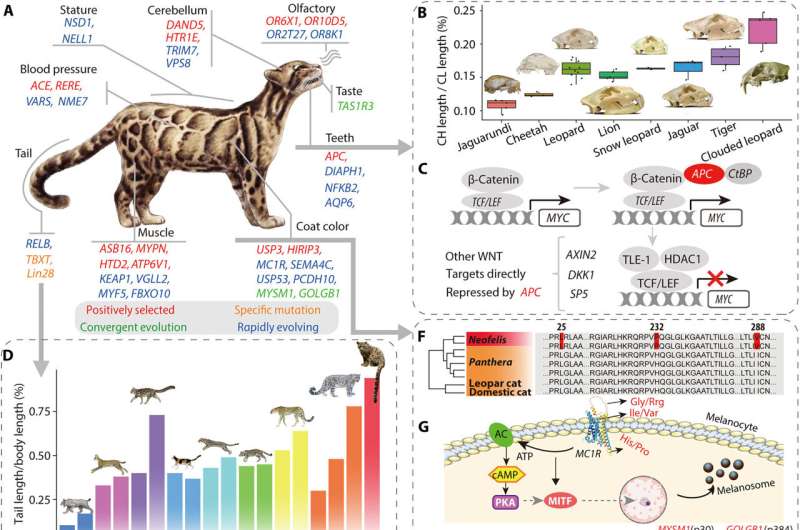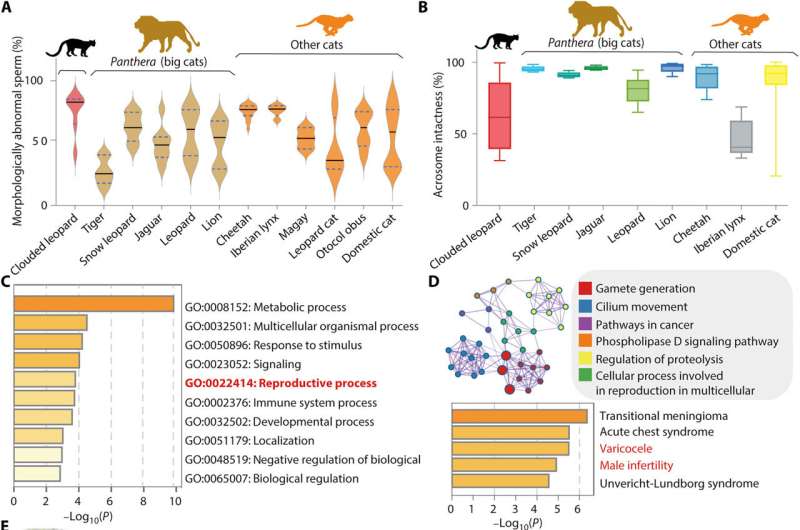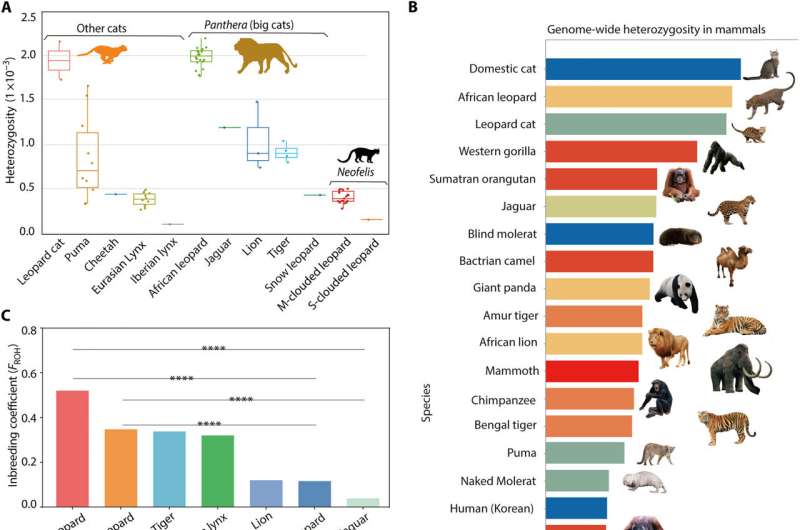October 25, 2023 feature
This article has been reviewed according to Science X's editorial process and policies. Editors have highlighted the following attributes while ensuring the content's credibility:
fact-checked
peer-reviewed publication
trusted source
proofread
Genomic insights reveal evolutionary history of clouded leopards, inform conservation
![Results of genome assembly and phylogenomic tests of clouded leopard. (A) An MCL. (B) Circos plot of chromosome alignment between clouded leopard (left) and domestic cat (right). The comparisons include gas chromatography content (I), gene density (II), repetitive elements [III: Short interspersed nuclear element (SINE), IV: Long interspersed nuclear elements (LINE), and V: Long terminal repeats (LTR)], and the inner curves of genome collinearity in 20-kb sliding windows. (C) Phylogenomic reconstruction and estimated divergence times (black numbers near each node) of genera Neofelis and Panthera. The expanded and contracted gene families (red and blue numbers) are shown near each branch. (D) Distribution of the genomic phylogenetic discordance across each chromosome of Neofelis tested by 50-kb sliding windows. The different colors represent the variable phylogenetic topologies of T0 to T3 shown in (E). (E) Topologies of the four most frequent sliding trees of T0 to T3 with estimated divergent times. NNE, Neofelis nebulosa; NDI, Neofelis diardi; FCA, Felis catus. (F) The introgression test between Neofelis and tiger [Panthera tigris (PTI)], leopard [Panthera pardus (PPA)], and lion [Panthera leo (PLE)]. Different colors marked six "trios" tests from 1 to 6. Credit: Science Advances (2023). DOI: 10.1126/sciadv.adh9143 Genomic insights shed light on the evolutionary history and conservation of clouded leopards](https://scx1.b-cdn.net/csz/news/800a/2023/genomic-insights-shed.jpg)
Both ecologically and morphologically, the clouded leopards known as Neofelis nebulosa are a distinct lineage of big cats. These species are threatened due to human activities of targeted hunting and habitat loss. Evolutionary biologists seek to understand the genetics of the species and their evolution through effective conservation actions.
In a new study now published in Science Advances, Jiaqing Yuan and a team of scientists in the life sciences, geosciences, natural sciences, genetics and integrative biosciences in China, U.S., and the U.K. described a comprehensive investigation of whole genomes, population genetics and adaptive evolution of Neofelis.
The genus Neofelis arose during the Pleistocene, which coincided with glacial-induced climate changes that led to the formation of savannas and rainforests.
These climate outcomes led to natural selection associated with genes functioning in tooth, pigmentation and tail development in the clouded leopard species. While population decline and interbreeding led to reduced genetic diversity, the deleterious variants of genes impacted the species reproduction, highlighting the significance of effective conservation efforts.
Mainland clouded leopards
Neofelis nebulosa and Neofelis diardi are two extant clouded leopard species that are the closest living relatives to the five big cats of the genus Panthera to form the subfamily Pantherinae. Since clouded leopards are highly adapted to an arboreal lifestyle, they have broad paws and a long tail for balance with flexible ankles to descend trees headfirst. These species have the largest upper canine teeth in proportion to body size, with canines in similar proportion to those of sabretooth cats. Despite their large upper canines, the clouded leopards do not kill their prey as sabretooths did, but instead use a crushing nape bite.

The species are endemic to South Asia, across the Himalayas to Sundaland. Although assumed to be a monospecific genus, Neofelis comprises two species. The mainland clouded leopard N. nebulosa distributed in Nepal, India, South China; and the Sunda clouded leopard that currently lives on the two islands of Borneo and Sumatra. The two species are listed as vulnerable and are found only in tropical forests—they have experienced 30% habitat loss in the past two decades.
Generating a reference genome
In this study, Yuan and colleagues generated a chromosome-level reference genome of the mainland clouded leopard to conduct comparative genomics aimed at revealing genomic signatures underlying the morphological adaptations of both species. They reconstructed the demographic history of the organisms to investigate the population bottlenecks related to species origin with paleoclimatic changes.
The work further highlighted the decreasing genetic diversity of the species and the accumulation of deleterious mutations to understand the effective management of the species in the wild and in enclosures.
Genomic data
The researchers sequenced the genome of the female N. nebulosa and the genome of a female N. diardi to gain insights to the evolutionary history of clouded leopard genetics. The team included genome comparisons between the mainland clouded leopard and the domestic cat Felis catus. They then aligned the genome of N. nebulosa with three Panthera species—tiger, lion, leopard and a domestic cat as the outgroup.
The outcomes showed the divergence between Neofelis and Panthera to have occurred approximately 6.19 million years ago. It appears that the rapid diversity of the herbivore populations led to the evolution of large mammalian carnivores, including abundant sources of food.
The team credited the divergence time of Neofelis to glacial movements that occurred during the early Pleistocene, where contracting rainforests were replaced by savannahs alongside humid limited tropical forests. The phylogenomic results indicated strong genetic isolation of clouded leopards from tiger, lion and leopard species, which the researchers credited to the highly specialized arboreal niche.
Forest adaptation in clouded leopard genome
The scientists compared the mountain clouded leopard and two small cats: the domestic cat and the Asian leopard cat. They identified core signatures of natural selection in the clouded leopard lineage to note single-copy orthologous shared between Neofelis and Panthera.
The clouded leopards showed the longest upper canines of all living cat species and maintained the highest ratio of tail length to head-to-body length in all Felidae species. Additionally, the species maintained cloud-like markings adapted for camouflage in the dappled light of dense forests.

Reproductive decline
The clouded leopards in ex situ conservation showed poor reproductive success due to structurally abnormal spermatozoa alongside abnormalities. The scientists noted the impact of the major histocompatibility complex genes on the immune response and its association with vertebrate reproduction.
Genetic diversity in clouded leopards
Yuan and team compared the average heterozygosity of clouded leopards for other cat species including the snow leopard, African cheetah and the Iberian lynx. The extremely low genomic heterozygosity and inbreeding severity among the species highlighted the need for urgent conservation efforts across species.
The scientists conducted population genetics and genome-wide selective sweep tests by investigating the population structure of 20 mountain cloud leopards. The data differentiated the leopards into two subspecies, N. nebulosa from China and South East Asia, and N. macrosceloides from Northern Myanmar and India, although the team did not observe distinct morphological differences between the two subspecies.

Outlook
Yuan and colleagues explored genetic adaptations of the mountain cloud leopard species using comparative genomic approaches to play crucial roles in determining the function of clouded leopards on arboreal habitats. The work showed high levels of inbreeding among the species that led to low levels of heterozygosity resulting from a probable cause association between the ancient ice age–induced climate changes that limited the species, with continued deterioration of the habitat, leading to high levels of inbreeding and deleterious genes.
The researchers highlighted the need for urgent action to ensure the survival of the big cat species and aim to use the knowledge of the genetic structure and evolutionary dynamics to maintain genetic diversity in the wild and in captivity to conserve and restore the clouded leopard species.
More information: Jiaqing Yuan et al, How genomic insights into the evolutionary history of clouded leopards inform their conservation, Science Advances (2023). DOI: 10.1126/sciadv.adh9143
Journal information: Science Advances
© 2023 Science X Network



















